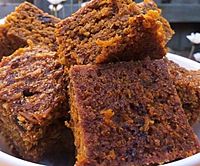Bibikkan facts for kids
 |
|
| Alternative names | Pol cake, Sri Lankan coconut cake |
|---|---|
| Type | Cake |
| Course | Dessert |
| Place of origin | Sri Lanka |
| Serving temperature | Cooled |
| Main ingredients | Coconut, Jaggery, Semolina, Spices |
| Variations | Brown sugar, rice flour |
Bibikkan (Sinhala: බිබික්කන්) is a delicious traditional cake from Sri Lanka. It is a dark, moist cake full of flavor. This special treat is made with shredded coconut, a sweet syrup called jaggery, and semolina. Many different spices are also added to make it taste amazing.
People in Sri Lanka often make and enjoy Bibikkan during big celebrations. These include holidays like Christmas, New Year's Eve, and the Sinhala and Tamil New Year. It's a cake that brings people together for happy times!
Contents
What is Bibikkan?
Bibikkan is a unique type of cake. It gets its rich, dark color and moist texture from its main ingredients. The cake is known for its deep, sweet taste. This comes from the jaggery, which is a natural sweetener.
It's a popular dessert that shows off Sri Lanka's rich food culture. Many families have their own special recipes. This makes each Bibikkan a little bit different and unique.
Where Did Bibikkan Come From?
Many people believe Bibikkan was first brought to Sri Lanka by the Portuguese. The Portuguese were in charge of the coastal parts of the island from 1505 to 1658. They introduced many new things, including some foods.
There's a similar dish called Bebinca in Goa, India. It's made by Goan Catholics. This cake is very much like Bibikkan. It also looks a lot like Bibingka, a traditional Filipino cake. Bibingka is made with rice flour and coconut milk. It is often eaten on Christmas Day.
Historically, an area in Sri Lanka called Mount Lavinia was famous for making Bibikkan. People there used to call it Poranu appa. This shows how old and important this cake is to the local culture.
How is Bibikkan Made?
Making Bibikkan involves a few steps. The main ingredients give it its special taste. These include jaggery, semolina, and fresh coconut.
Key Ingredients
- Jaggery: This is a natural, unrefined syrup. It comes from the sap of the Kithul palm tree. It has a rich flavor. It tastes a bit like caramel and molasses.
- Semolina: This is a type of flour. It can be dry roasted before use. Sometimes, rice flour is used instead.
- Coconut: Freshly grated or shredded coconut is a must. It gives the cake its tropical flavor.
The Baking Process
First, the semolina is often dry roasted. This helps to bring out its flavor. Next, the jaggery is dissolved in hot water and boiled. Then, the shredded coconut is added to this sweet mixture.
This mix is allowed to cool down. After it cools, many other ingredients are added. These include the semolina, cardamom, nutmeg, mace, and ginger preserve. Candied fruit peel, cashew nuts, salt, and baking powder are also mixed in. Finally, Sri Lankan cinnamon is added for a warm spice flavor. Everything is blended very well.
Eggs are separated, and the whites and yolks are whisked on their own. The egg yolks are mixed into the batter first. Then, lime rind is added for a fresh citrus hint. Finally, the whisked egg whites are gently folded in. This helps make the cake light and fluffy. The mixture is poured into a buttered baking tray. It is then baked in a moderate oven until it's ready. Once baked, it's left to cool. Then, it's cut into squares and served.

